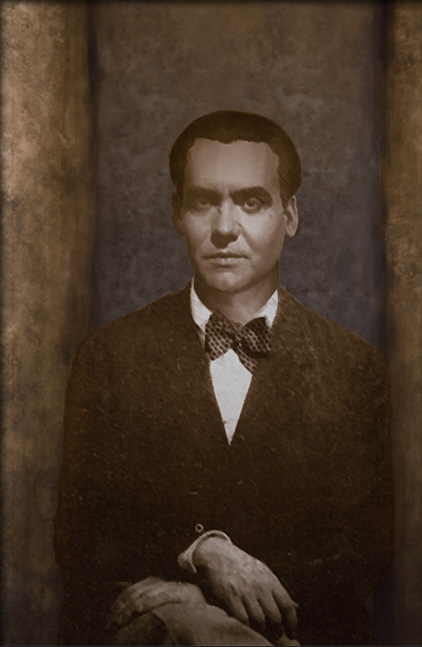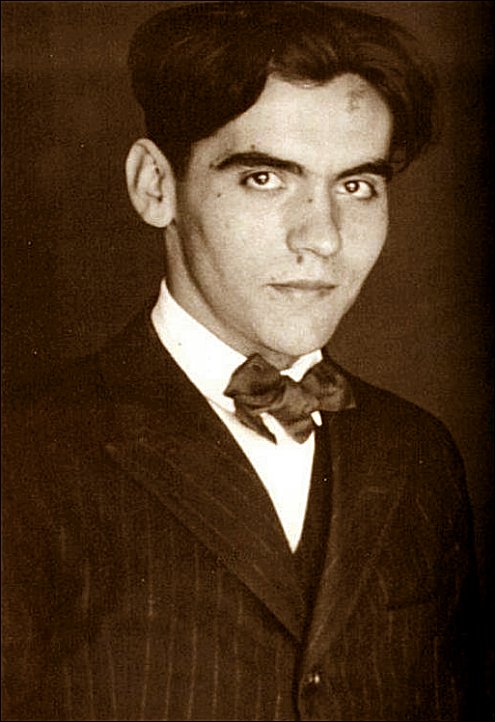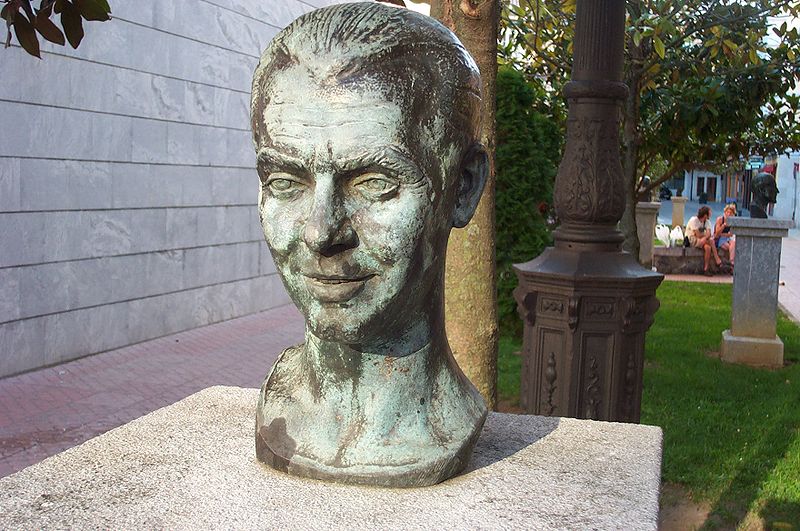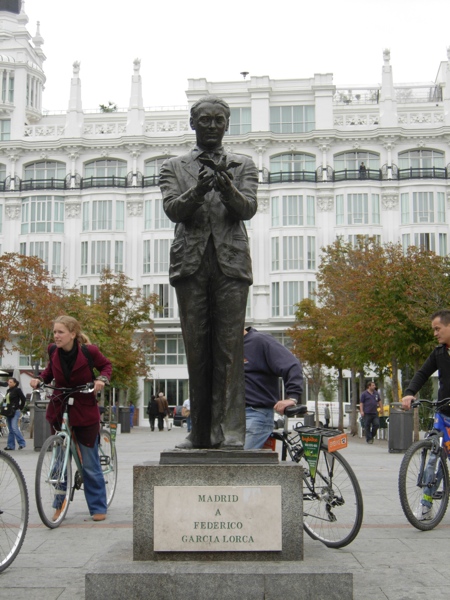<Back to Index>
- Poet and Dramatist Federico del Sagrado Corazón de Jesús García Lorca, 1898
PAGE SPONSOR

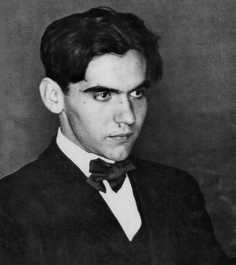
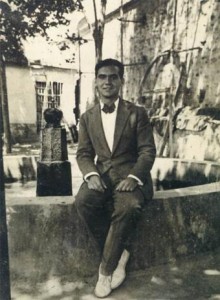
Federico del Sagrado Corazón de Jesús García Lorca (5 June 1898 – 19 August 1936) was a Spanish poet, dramatist and theatre director. García Lorca achieved international recognition as an emblematic member of the Generation of '27. He is believed to be one of thousands who were summarily shot by anti - communist death squads during the Spanish Civil War. In 2008, a Spanish judge opened an investigation into Lorca's death. The Garcia Lorca family eventually dropped objections to the excavation of a potential gravesite near Alfacar. However, no human remains were found.
García Lorca was born on 5 June 1898, in Fuente Vaqueros, a small town a few miles west of Granada, southern Spain. His father, Federico García Rodríguez, was a landowner with a farm in the fertile vega surrounding Granada and a comfortable villa in the heart of the city. García Rodríguez saw his fortunes rise with a boom in the sugar industry. García Lorca's mother, Vincenta Lorca Romero, was a teacher and gifted pianist. In 1909, when the boy was 11, his family moved to the city of Granada. For the rest of his life, he maintained the importance of living close to the natural world, praising his upbringing in the country. In 1915, after graduating from secondary school, García Lorca attended Sacred Heart University. During this time his studies included law, literature and composition. Throughout his adolescence he felt a deeper affinity for theater and music than literature, training fully as a classical pianist, his first artistic inspirations arising from the scores of Debussy, Chopin and Beethoven. Later, with his friendship with composer Manuel de Falla Spanish folklore became his muse. García Lorca did not begin a career in writing until his piano teacher died in 1916 and his first prose works such as "Nocturne", "Ballade" and "Sonata" drew on musical forms. His milieu of young artists gathered in El Rinconcillo at the cafe Alameda in Granada. During 1916 and 1917, García Lorca traveled throughout Castile, Léon, and Galicia, in northern Spain, with a professor of his university, who also encouraged him to write his first book, Impresiones y Paisajes (Impressions and Landscapes – published 1918). Don Fernando de los Rios persuaded García Lorca's parents to allow the boy to enroll at the progressive, Oxbridge - inspired Residencia de estudiantes in Madrid in 1919.
At the Residencia de estudiantes in Madrid García Lorca befriended Manuel de Falla, Luis Buñuel and Salvador Dalí and many other creative artists who were, or would become, influential across Spain. He was taken under the wing of the poet Juan Ramon Jimenez, becoming close to playwright Eduardo Marquina and Gregorio Martínez Sierra, the Director of Madrid's Teatro Eslava. In 1919 – 20, at Sierra's invitation, he wrote and staged his first play, El maleficio de la mariposa (The Butterfly's Evil Spell). It was a verse play dramatizing the impossible love between a cockroach and a butterfly, with a supporting cast of other insects; it was laughed off stage by an unappreciative public after only four performances and influenced García Lorca's attitude to the theater going public for the rest of his career. He would later claim that Mariana Pineda, written in 1927, was, in fact, his first play. During the time at the Residencia de estudiantes he pursued degrees in law and philosophy though he had more interest in writing than in studying.
García
Lorca's first book of poems was published in 1921, collecting work
written from 1918 and selected with the help of his brother Francisco.
They concern the themes of religious faith, isolation and nature that
had filled his prose reflections. Early in 1922 at Granada García Lorca joined the composer Manuel de Falla in order to promote the Concurso de Cante Jondo, a festival dedicated to enhance flamenco performance. The year before Lorca had begun to write his Poema del cante jondo (Poem of the deep song, not published until 1931), so he naturally composed an essay on the art of flamenco, and began to speak publicly in support of the Concurso. At the music festival in June he met the celebrated Manuel Torre,
a flamenco cantaor. The next year in Granada he also collaborated with
Falla and others on the musical production of a play for children,
adapted by Lorca from an Andalucian story. Inspired by the same structural form of sequence as "Deep song", his collection Suites (1923) was never finished and not published until 1983.
Over the next few years García Lorca became increasingly involved in Spain's avant - garde. He published poetry collections including Canciones (Songs) and Romancero Gitano (Gypsy Ballads, 1928), which became his best known book of poetry. It was a highly stylized imitation of the ballads and poems that were still being told throughout the Spanish countryside. Philologists such as Ramón Menéndez Pidal worked with him to collect versions from the south, many in existence since the Middle Ages. García Lorca describes the work as a "carved altar piece" of Andalusia with "gypsies, horses, archangels, planets, its Jewish and Roman breezes, rivers, crimes, the everyday touch of the smuggler and the celestial note of the naked children of Córdoba. A book that hardly expresses visible Andalusia at all, but where the hidden Andalusia trembles". In 1928, the book brought him fame across Spain and the Hispanic world, and he only gained notability as a playwright much later. For the rest of his life, the writer would search for the elements of Andalusian culture, trying to find its essence without resorting to the "picturesque" or the cliched use of "local colour".
His second play Mariana Pineda, with stage settings by Salvador Dalí, opened to great acclaim in Barcelona in 1927. In 1926, García Lorca wrote the play The Shoemaker's Prodigious Wife which would not be shown until the early 1930s. It was a farce about fantasy, based on the relationship between a flirtatious, petulant wife and a hen - pecked shoemaker.
From 1925 to 1928 he was passionately involved with Dalí. The friendship with Lorca had a strong element of mutual passion, but Dalí (decades later) rejected the erotic advances of the poet. With the success of "Gypsy Ballads", came an estrangement from Dali and the breakdown of a love affair with sculptor Emilio Soriano Aladrén. These brought on an increasing depression, a situation exacerbated by his anguish over his homosexuality. He felt he was trapped between the persona of the successful author, which he was forced to maintain in public, and the tortured, authentic self, which he could only acknowledge in private. He also had the sense that he was being pigeon - holed as a "gypsy poet". He wrote "The gypsies are a theme. And nothing more. I could just as well be a poet of sewing needles or hydraulic landscapes. Besides, this gypsyism gives me the appearance of an uncultured, ignorant and primitive poet that you know very well I’m not. I don't want to be typecast". Growing estrangement between García Lorca and his closest friends reached its climax when surrealists Dalí and Luis Buñuel collaborated on their 1929 film Un Chien Andalou (An Andalusian Dog). García Lorca interpreted it, perhaps erroneously, as a vicious attack upon himself. At this time Dalí also met his future wife Gala. Aware of these problems (though not perhaps of their causes), García Lorca's family arranged for him to take a lengthy visit to the United States in 1929 – 30.
In June 1929, García Lorca travelled to America with Fernando de los Rios on the SS Olympic, a sister liner to the Titanic. They stayed mostly in New York City, where Rios started a lecture tour and García Lorca enrolled at Columbia University School of General Studies,
funded by his parents. He studied English but as before, was more
absorbed by writing than study. He also spent time in Vermont and later
in Havana, Cuba. His collection Poeta en Nueva York (A poet in New York,
published posthumously in 1942) explores alienation and isolation
through some graphically experimental poetic techniques and was
influenced by the Wall Street crash which
he personally witnessed. This condemnation of urban capitalist society
and materialistic modernity was a sharp departure from his earlier work
and label as a folklorist. His play of this time El Público (The Public)
was not published until the late 1970s and has never been published in
its entirety, the manuscript lost. However, the Hispanic Society of
America in New York City retains several of his personal letters.
García Lorca's return to Spain in 1930 coincided with the fall of the dictatorship of Primo de Rivera and the re-establishment of the Spanish Republic. In 1931, García Lorca was appointed as director of a university student theater company, Teatro Universitario la Barraca (The Shack). This was funded by the Second Republic's Ministry of Education, and it was charged with touring Spain's remotest rural areas in order to introduce audiences to radically modern interpretations of classic Spanish theater free of charge. With a portable stage, and little equipment, they sought to bring theater to people who had never seen any, with García Lorca directing as well as acting. He commented: "Outside of Madrid, the theater, which is in its very essence a part of the life of the people, is almost dead, and the people suffer accordingly, as they would if they had lost their two eyes, or ears, or a sense of taste. We [La Barraca] are going to give it back to them". His experiences of traveling through impoverished rural Spain and New York, (particularly amongst the disenfranchised African American population), transformed him into a passionate advocate of the theater of social action. He wrote "The theater is a school of weeping and of laughter, a free forum, where men can question norms that are outmoded or mistaken and explain with living example the eternal norms of the human heart".
While touring with La Barraca, García Lorca wrote his now best known plays, the Rural Trilogy of Bodas de Sangre (Blood Wedding), Yerma and La Casa de Bernarda Alba (The House of Bernarda Alba), which all rebelled against the norms of bourgeois Spanish society. He called for a rediscovery of the roots of European theater and the questioning of comfortable conventions such as the popular drawing room comedies of the time. His work challenged the accepted role of women in society and explored taboo issues of homoeroticism and class. García Lorca wrote little poetry in this last period of his life, declaring in 1936, “theater is poetry that rises from the book and becomes human enough to talk and shout, weep and despair.”
Traveling to Buenos Aires in 1933 to give lectures and direct the Argentine premiere of Blood Wedding, García Lorca spoke of his distilled theories on artistic creation and performance in the famous lecture Play and Theory of the Duende. This attempted to define a schema of artistic inspiration, arguing that great art depends upon a vivid awareness of death, connection with a nation's soil, and an acknowledgment of the limitations of reason.
As well as returning to the classical roots of theater, García Lorca also turned to traditional forms in poetry. His last poetic work Sonnets to his dark love (1936) was inspired by a passion for Rafael Rodriguez Rapun, secretary of La Barraca. The love sonnets are inspired by the 16th century poet San Juan de la Cruz. La Barraca's subsidy was cut in half by the new government in 1934, and its last performance was given in April 1936.
Lorca kept Huerta de San Vicente as his summer house in Granada from 1926 to 1936. Here he wrote, totally or in part, some of his major works, among them When Five Years Pass (Así que pasen cinco años) (1931), Blood Wedding (Bodas de sangre) (1932), Yerma (1934) and Diván del Tamarit (1931 – 1936). The poet lived in the Huerta de San Vicente in the days just before his arrest and assassination in August 1936.
Although García Lorca's artwork doesn't often receive attention he was also a keen artist.
García Lorca left Madrid for his family home in Granada only three days before the Spanish Civil War broke out (July 1936). The Spanish political and social climate had greatly intensified after the murder of prominent monarchist and anti - Popular Front spokesman José Calvo Sotelo by Republican Assault Guards (Guardia de Asalto). García Lorca knew that he would be suspect to the rising right wing for his outspoken liberal views. On 18 August, his brother - in - law, Manuel Fernández - Montesinos, the leftist mayor of Granada, was shot. Lorca was arrested that same afternoon.
It is thought that García Lorca was shot and killed by Nationalist militia on 19 August 1936. The author Ian Gibson in his book The Assassination of García Lorca alleges that he was shot with three others (Joaquin Arcollas Cabezas, Francisco Galadi Mergal and Dioscoro Galindo Gonzalez) at a place known as the Fuente Grande, or Great Fountain in Spanish, which is on the road between Viznar and Alfacar.
Significant
controversy remains about the motives and details of Lorca's murder.
Personal, non - political motives have also been suggested.
García Lorca's biographer, Stainton, states that his killers made
remarks about
his sexual orientation, suggesting that it played a role in his death. Ian Gibson suggests
that García Lorca's assassination was part of a campaign of mass
killings intended to eliminate supporters of the Marxist Popular Front. However, Gibson proposes that rivalry between the anti - communist Spanish Confederation of the Autonomous Right (CEDA) and the Falange was a major factor in Lorca's death. Former CEDA Parliamentary Deputy Ramon Ruiz Alonso arrested
García Lorca at the Rosales' home, and was the one responsible
for the original denunciation that led to the arrest warrant being
issued.
It has been argued that García Lorca was apolitical and had many friends in both Republican and Nationalist camps. Gibson disputes this in his 1978 book about the poet's death. He cites, for example, Mundo Obrero's published manifesto, which Lorca later signed, and alleges that Lorca was an active supporter of the Popular Front. Lorca read this manifesto out at a banquet in honor of fellow poet Rafael Alberti on 9 February 1936.
Many
anti - communists were sympathetic to Lorca or assisted him. In the days
before his arrest he found shelter in the house of the artist and
leading Falange member Luis Rosales.
Indeed, evidence suggests that Rosales was very nearly shot as well for
helping García Lorca by the Civil Governor Valdes.The Basque Communist poet Gabriel Celaya wrote in his memoirs that he once found García Lorca in the company of Falangist José Maria Aizpurua. Celaya further wrote that Lorca dined every Friday with Falangist founder and leader José Antonio Primo de Rivera. On 11 March 1937 an article appeared in the Falangist press
denouncing the murder and lionizing García Lorca; the article
opened: "The finest poet of Imperial Spain has been assassinated." Jean - Louis Schonberg also put forward the 'homosexual jealousy' theory. The dossier on the murder, compiled at Franco's request and referred to by Gibson and others, has yet to surface.
In late October 2009, a team of archaeologists and historians from the University of Granada began excavations outside Alfácar. The site was identified three decades ago by a man who claimed to have helped dig Lorca's grave. Lorca was thought to be buried with at least three other men beside a winding mountain road that connects the villages of Viznar and Alfácar.
There is a growing desire in Spain to come to terms with the civil war, which for decades was not openly discussed. The judge in the case, Baltasar Garzón, formally requested local government and churches to open their files on the thousands of people who disappeared during the Civil War and under the dictatorship of General Franco until 1975.
The excavations began at the request of another victim's family. Following a long standing objection, the Lorca family also gave their permission. In October 2009 Francisco Espinola, a spokesman for the Justice Ministry of the Andalusian regional government, said that after years of pressure García Lorca's body would "be exhumed in a matter of weeks". Lorca's relatives, who had initially opposed an exhumation, said they might provide a DNA sample in order to identify his remains.
In
late November 2009, after two weeks of excavating the site, organic
material believed to be human bones was recovered. The remains were
taken to the University of Granada for examination. But in mid December 2009, doubts were raised as to whether the poet's remains would be found. The
dig produced "not one bone, item of clothing or bullet shell", said
Begoña Álvarez, justice minister of Andalucia. She added,
"the soil was only 40cm (16in) deep, making it too shallow for a grave".
Francisco Franco's Falangist regime placed a general ban on García Lorca's work, which was not rescinded until 1953. That year, a (censored) Obras Completas (Complete works) was released. Following this, Bodas de Sangre (Blood Wedding), Yerma and La casa de Bernarda Alba (The House of Bernarda Alba) were successfully played on the main Spanish stages. Obras Completas did not include his late heavily homoerotic Sonnets of Dark Love, written in November 1935 and shared only with close friends. They were lost until 1983/4 when they were finally published in draft form (no final manuscripts have ever been found.) It was only after Franco's death that García Lorca's life and death could be openly discussed in Spain. This was due not only to political censorship, but also to the reluctance of the García Lorca family to allow publication of unfinished poems and plays prior to the publication of a critical edition of his works.
South African Roman Catholic poet Roy Campbell, who enthusiastically supported the Nationalists both during and after the Civil War, later produced acclaimed translations of Lorca's work. In his poem, The Martyrdom of F. Garcia Lorca, Campbell wrote,
- Not only did he lose his life
- By shots assassinated:
- But with a hammer and a knife
- Was after that -- translated.
In Granada, the city of his birth, the Parque Federico Garcia Lorca is dedicated to his memory and includes the Huerta de San Vicente, the Lorca family summer home, opened to the public in 1995 as a museum. The grounds, including nearly two hectares of land, the two adjoining houses, artworks and the original furnishings have been preserved. There is a new statue of Lorca on the Avenida de la Constitución in the city center, and a new cultural center bearing his name is currently under construction and will play a major role in preserving and disseminating his works.
The Parque Federico Garcia Lorca, in Alfacar, is situated close to Fuente Grande and was the location of the unsuccessful 2009 excavations that failed to locate Lorca´s resting place. Close to the olive tree indicated by some as marking the location of the grave, there is a stone memorial to Federico Garcia Lorca and all victims of the Civil War, 1936 - 39. Flowers are laid at the memorial every year on the anniversary of his death, and a commemorative event including music and readings of the poet´s works is held every year in the park to mark the anniversary. On the 17th August 2011, to remember the 75th anniversary of Lorca´s assassination and to celebrate his life and legacy, this event included dance, song, poetry and dramatic readings and attracted hundreds of spectators.
At the Barranco de Viznar, between Viznar and Alfacar, there is a memorial stone bearing the words "Lorca eran todos, 18-8-2002". The Barranco de Viznar is the site of mass graves and was proposed as another possible location of the poet´s remains.
García Lorca is honored by a statue prominently located in Madrid's Plaza de Santa Ana. Political philosopher David Crocker reports that "the statue, at least, is still an emblem of the contested past: "each day, the Left puts a red kerchief on the neck of the statue, and someone from the Right comes later to take it off."
The Lorca Foundation, directed by Lorca's niece Laura García Lorca, sponsors the celebration and dissemination of the writer's work and is currently building the Lorca Center in Madrid. The Lorca family gave all Lorca's documentation to the foundation which holds it on their behalf.
Then I realized I had been murdered.
They looked for me in cafes, cemeteries and churches
.... but they did not find me.
They never found me?
No. They never found me.
Poet in New York (1939), Garcia Lorca
